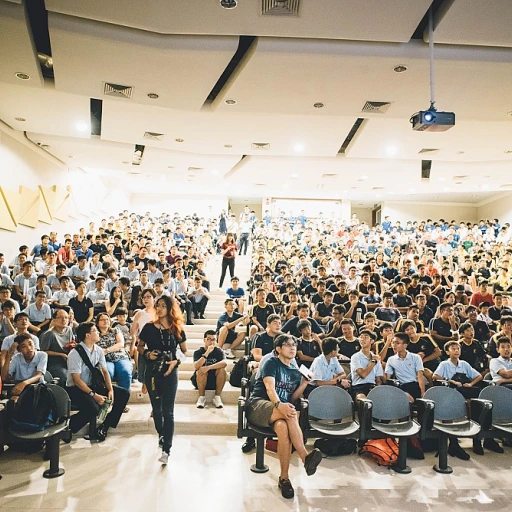Understanding AI in Performance Reviews
Unveiling the Role of AI in Employee Evaluations
The integration of AI in performance evaluations is revolutionizing how organizations assess employee performance. AI tools, like evaluation generators and performance review creators, are playing an instrumental role in creating precise and timely feedback for employees. These tools can generate specific and constructive feedback by analyzing large data sets and identifying patterns that human evaluators might miss. The use of technology in reviews is becoming more prevalent, reflecting a shifting focus towards utilizing high-quality, data-driven insights in the evaluation process. This transition is indicative of a new era in human resources, where traditional methods are being enhanced by the capabilities of AI.
AI-powered writing tools aid in maintaining professionalism and clarity in performance reviews by suggesting content enhancements, thereby ensuring that feedback remains both constructive and positive. By highlighting areas of improvement and areas where employees excel, AI-driven review generators support managers in providing balanced feedback. This approach not only aids in performance management but also fosters professional growth and development among employees.
Benefits of AI-Driven Evaluations
Leveraging AI for Comprehensive Feedback
Innovative employment of artificial intelligence tools in performance assessments offers notable advantages. AI enables organizations to generate high-quality performance reviews by systematically analyzing employee performance data. By utilizing AI, companies can transform feedback into actionable insights that specifically target areas for improvement. These tools function as review generators, streamlining the entire performance review process. For instance, AI can create professional review templates, providing standardized evaluations that maintain consistency across the board. This consistency ensures that every employee receives a fair and unbiased assessment, devoid of human biases that can cloud judgments. Moreover, AI-driven tools for reviews offer organizations the capability to generate constructive feedback tailored to individuals' specific needs. Such feedback allows employees to understand their strengths and pinpoint areas which require further development. With the aid of these review generators, HR departments can harness the power of AI to provide personalized, timely reviews that have a real impact on employee growth. Furthermore, AI can help identify patterns that may have been overlooked previously. These insights not only enhance the precision of performance evaluations but also serve as a compass to guide leadership in fostering a culture of continuous improvement. Mastering comprehensive feedback through AI equips HR professionals with innovative strategies to nurture employee potential. For more on optimizing HR strategies, explore mastering human resources with innovative strategies.Challenges and Considerations
Overcoming AI Integration Challenges
Incorporating AI tools into employee performance review processes offers substantial benefits but comes with its share of challenges. One significant roadblock is the concern over accuracy and bias in evaluations. Since AI algorithms derive insights from historical data, it’s crucial to ensure this data is representative and unbiased, preventing skewed feedback or unfair assessments.
Integrating AI-driven evaluation tools requires addressing several key areas:
- Algorithm Transparency: It’s essential to understand how AI generates its recommendations to ensure trust and transparency. Allowing HR professionals and employees to comprehend the data sources and mechanisms behind AI conclusions will boost confidence in the system.
- Data Privacy: Safeguarding sensitive employee data is imperative when utilizing AI tools. Organizations must ensure that their performance review software adheres to data protection regulations and that employee information is securely managed.
- Human Oversight: Despite the advanced capabilities of AI, human involvement remains crucial. Managers may need to verify AI-generated feedback to provide personalized, high-quality reviews.
Additionally, the integration of AI tools must consider costs and training requirements. Companies should evaluate whether investing in AI tools aligns with their current human resources management strategy and determine the resources required to train staff to effectively use the technology. The seamless implementation of AI development tools into your company culture will play a pivotal role in achieving the desired improvements in the performance review process.
Finally, the choice of AI tools should be tailored to the specific needs of the organization, enabling reviews that address individual employee success and areas of improvement. By proactively tackling these challenges, companies can set themselves up for success, leveraging AI not just as a tool but as a key asset in professional writing and employee development.
Case Studies: AI in Action
Real-World Experiences with AI in Employee Evaluations
In recent years, AI tools have revolutionized the landscape of employee evaluations by providing new insights and efficiencies in the performance review process. As organizations explore AI-driven evaluations, several case studies have emerged showcasing the practical implementation and outcomes of these technologies.- Improving Feedback Quality: One organization integrated an AI-generated feedback system that automatically generated constructive feedback for employee performance reviews. This tool analyzed specific areas of performance and provided high quality, professional suggestions for areas of improvement. The use of this technology resulted in feedback that was both free from personal biases and more helpful in driving employee development.
- Streamlined Review Templates: Another company adopted a review generator tool to create professional review templates, easing the burden on managers during the review process. By using such tools, feedback was consistent across various departments, enhancing the transparency and fairness of evaluations.
- Employee Performance Tracking: Implementing an AI tool for real-time performance tracking allowed one business to generate real-time notifications and feedback. Managers were equipped to address employee performance issues promptly, leading to improved productivity and employee satisfaction.
Future Trends in AI and HR
Predictive Analytics and Personalized Feedback Systems
AI tools are revolutionizing the way employee performance reviews are conducted by introducing predictive analytics and personalized feedback systems. These advancements not only make the review process more efficient but also enhance the quality of feedback provided to employees. By using performance review generators, HR professionals can analyze vast amounts of performance data to identify trends and predict future performance outcomes.Integration of Free Tools and Professional Writing Systems
The integration of high-quality, free performance review generators and professional writing tools has expanded the capabilities of HR departments. These tools assist in creating structured feedback, pinpointing areas of improvement, and generating review templates that cater to specific employee roles and responsibilities. By enhancing how feedback is provided, these systems help maintain high levels of employee engagement and motivation.AI’s Role in Collaborative Feedback Generation
AI enhances the collaborative aspect of performance reviews by facilitating real-time feedback among team members and supervisors. This collaborative effort can lead to more rounded evaluations, offering a balanced view of an employee’s performance. The use of AI in the review process ensures that feedback is comprehensive, focusing on both strengths and areas that require improvement.Embracing AI for Continuous Improvement
As organizations continue to adopt AI-driven solutions, the potential to generate quality employee evaluations becomes apparent. These tools help streamline the review process, ensuring that reviews are not only consistent but also focus on constructive feedback, enabling employees to focus on areas that require attention. With the promise of continuous improvement, integrating AI into HR practices seems to be a vital step toward enhancing overall organizational performance.Implementing AI in Your Organization
Steps to Successfully Implement AI-Powered Evaluation Tools
Introducing AI-driven evaluation tools into your organization can transform how performance reviews are conducted. However, ensuring their successful implementation requires careful planning and execution. Here’s a guide to help ease the transition and create high-quality performance evaluations.- Identify Objectives and Specific Needs: Before adopting any review generator, it is crucial to identify what specific areas of employee performance need addressing. Effective use of an evaluation generator tool can help create free performance reviews tailored to those needs, ensuring comprehensive assessments.
- Choose the Right Tool: Not all tools are created equal. Look for a professional writing tool that aligns with your objectives. Consider free options for initial trial, but prioritize those offering high-quality performance review generation and the ability to generate constructive feedback. The suitable tool will not only enhance the review process but also facilitate writing professional evaluations.
- Train Your Team: AI tools, though powerful, still require human input for success. Train your HR team to proficiently utilize letter generators and review templates. By understanding how to leverage these tools, your team will generate insightful feedback and assess employee performance more effectively.
- Integrate Feedback Mechanisms: Encourage employees to offer feedback about the review process itself. Their insights will help you fine-tune the tool usage and highlight areas for improvement. Utilizing a review generator facilitate capturing valuable feedback in a more structured way, thus improving the overall effectiveness.
- Continuously Monitor and Optimize: Improvement does not stop at implementation. Regular assessment of the tool’s impact on performance reviews will reveal areas where adjustment may be necessary. Remain adaptable to changes and keep updating the process for continuous enhancement.
- Foster an Open Culture: Encourage open communication about the role of AI in evaluations. Transparency will dispel potential reservations, and the professional implementation of the tool can inspire confidence in its ability to generate objective and fair reviews.








